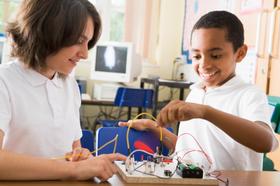Top Rankings
Buffalo-Hanover-Montrose Schools School District ranks among the top 20% of public school district in Minnesota for:
Category
Attribute
Math Proficiency
Highest math proficiency (Top 20%)
Graduation Rate
Highest graduation rate (Top 5%)
Community Size
Largest student body (number of students) (Top 1%)
For the 2025 school year, there are 3 public preschools serving 856 students in Buffalo-Hanover-Montrose Schools School District. This district's average pre testing ranking is 6/10, which is in the top 50% of public pre schools in Minnesota.
Public Preschools in Buffalo-Hanover-Montrose Schools School District have an average math proficiency score of 52% (versus the Minnesota public pre school average of 46%), and reading proficiency score of 55% (versus the 47% statewide average).
Minority enrollment is 16% of the student body (majority Hispanic), which is less than the Minnesota public preschool average of 42% (majority Hispanic and Black).
Overview
This School District
This State (MN)
# Schools
11 Schools
722 Schools
# Students
5,282 Students
214,815 Students
# Teachers
298 Teachers
16,916 Teachers
Student : Teacher Ratio
18:1
18:1
Student By Grade
District Rank
Buffalo-Hanover-Montrose Schools School District, which is ranked within the top 20% of all 520 school districts in Minnesota (based off of combined math and reading proficiency testing data) for the 2022-2023 school year.
The school district's graduation rate of 93% has stayed relatively flat over five school years.
Overall District Rank
#108 out of 525 school districts
(Top 30%)
(Top 30%)
Math Test Scores (% Proficient)
52%
46%
Reading/Language Arts Test Scores (% Proficient)
55%
51%
Science Test Scores (% Proficient)
44%
41%
Graduation Rate
93%
84%
Students by Ethnicity:
Diversity Score
0.25
0.63
% American Indian
n/a
2%
% Asian
1%
7%
% Hispanic
5%
13%
% Black
3%
13%
% White
87%
58%
% Hawaiian
n/a
n/a
% Two or more races
4%
7%
All Ethnic Groups
District Revenue and Spending
The revenue/student of $16,989 in this school district is less than the state median of $17,854. The school district revenue/student has stayed relatively flat over four school years.
The school district's spending/student of $15,027 is less than the state median of $18,580. The school district spending/student has stayed relatively flat over four school years.
Total Revenue
$90 MM
$15,547 MM
Spending
$79 MM
$16,179 MM
Revenue / Student
$16,989
$17,854
Spending / Student
$15,027
$18,580
Best Buffalo-Hanover-Montrose Schools School District Public Preschools (2025)
School
(Math and Reading Proficiency)
(Math and Reading Proficiency)
Location
Grades
Students
Rank: #11.
Parkside Elementary School
(Math: 60-64% | Reading: 55-59%)
Rank:
Rank:
9/
Top 20%10
207 3rd St Ne
Buffalo, MN 55313
(763) 682-8500
Buffalo, MN 55313
(763) 682-8500
Grades: PK-5
| 340 students
Rank: #22.
Montrose Elementary School Of Innov
(Math: 40-44% | Reading: 50-54%)
Rank:
Rank:
6/
Top 50%10
100 2nd St S
Montrose, MN 55363
(763) 682-8345
Montrose, MN 55363
(763) 682-8345
Grades: PK-5
| 357 students
Rank: n/an/a
Buffalo Early Child. Sp. Educational Program
Special Education School
214 Ne 1st Ave
Buffalo, MN 55313
(763) 682-8721
Buffalo, MN 55313
(763) 682-8721
Grades: PK
| 159 students
Recent Articles

The 15 Biggest Failures of the American Public Education System
The world is in a constant state of change and those who fail to adjust fall behind. Unfortunately, the American public education system has not kept up with the times and is currently facing a number of serious problems. Keep reading to learn about the biggest failures affecting the modern U.S. public education system as well as some of the trends that could spark change.

Florida Governor Calls for More Funding for State鈥檚 Public School System
Florida Governor Rick Scott has introduced a state budget for next year that pumps one billion more dollars into the public school system. We鈥檒l look at his reasons for the increase and the responses to the proposal.

Can Your Child鈥檚 School Meet the National Standards?
The article discusses the challenges public schools face in meeting national educational standards. It examines current performance trends, identifies key issues affecting student achievement, and explores potential solutions for improving academic outcomes across U.S. public schools.





